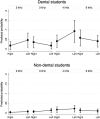Increased Signs of Noise-Induced Hearing Loss in Dental Students: A Multilevel Approach
- PMID: 36124524
- PMCID: PMC9743310
- DOI: 10.4103/nah.nah_21_21
Increased Signs of Noise-Induced Hearing Loss in Dental Students: A Multilevel Approach
Abstract
Context: Despite the fact that the new generations of rotary tools emit less noise, some recent studies suggest that dental students are still at risk of hearing impairment.
Aims: The aim of the study was to determine a possible association between noise exposure from dental equipment and early signs of noise-induced hearing loss (NIHL) in dental students.
Settings and design: A cross-sectional study was carried out with dental and non-dental students from two universities in Chile.
Methods and material: A group of 102 dental students routinely exposed to noise emitted from dental equipment was selected as the study group. A group of 251 non-dental students was selected as the control group. Pure-tone audiometry was carried out on all participants ensuring that they were not exposed to noise for at least 24 hours prior to testing. The presence of a notch was determined for each participant.
Statistical analysis used: Simultaneous-quantile regressions were used to compare percentiles of the hearing threshold between both groups. Then, the notch prevalence ratio adjusted by gender and age was estimated for each group of participants. Finally, the prevalence of an audiometric notch was compared between both groups using logistic regression models and generalized linear methods. Both fixed effect and multilevel hierarchy models were constructed.
Results: Significant differences between groups for the 75th percentile of hearing threshold distributions at 4 and 6 kHz in the left ear and at 6 kHz in the right ear were found. In addition, study group participants exhibited a significantly higher prevalence of a notch at 4 kHz in the left ear than control group participants.
Conclusions: Exposure to noise derived from learning activities as a dental student is associated with early signs of NIHL. Such signs include poorer hearing thresholds than those of non-dental students at 4 and 6 kHz as well as the presence of a notch at high frequencies.
Keywords: Dental student; multilevel hierarchy models; noise-induced hearing loss; notch prevalence.
Conflict of interest statement
None
Figures


Similar articles
-
Occupational hearing loss of market mill workers in the city of Accra, Ghana.Noise Health. 2014 May-Jun;16(70):183-8. doi: 10.4103/1463-1741.134919. Noise Health. 2014. PMID: 24953884
-
Audiometric notch as a sign of noise induced hearing loss.Occup Environ Med. 2001 Jan;58(1):46-51. doi: 10.1136/oem.58.1.46. Occup Environ Med. 2001. PMID: 11119634 Free PMC article.
-
Noise Exposure History and Age-Related Changes to Hearing.JAMA Otolaryngol Head Neck Surg. 2025 Mar 1;151(3):228-235. doi: 10.1001/jamaoto.2024.4768. JAMA Otolaryngol Head Neck Surg. 2025. PMID: 39786765
-
High-Frequency Audiometry for Early Detection of Hearing Loss: A Narrative Review.Int J Environ Res Public Health. 2021 Apr 28;18(9):4702. doi: 10.3390/ijerph18094702. Int J Environ Res Public Health. 2021. PMID: 33925120 Free PMC article. Review.
-
Does health promotion work in relation to noise?Noise Health. 2003 Jan-Mar;5(18):25-30. Noise Health. 2003. PMID: 12631433 Review.
Cited by
-
Changes in Plasma Levels of Prestin and Otolin-1 in Dental Students.Cureus. 2024 Dec 14;16(12):e75719. doi: 10.7759/cureus.75719. eCollection 2024 Dec. Cureus. 2024. PMID: 39811239 Free PMC article.
References
-
- Gijbels F, Jacobs R, Princen K, Nackaerts O, Debruyne F. Potential occupational health problems for dentists in Flanders, Belgium. Clin Oral Investig. 2006;10:8–16. - PubMed
-
- Wilson CE, Vaidyanathan TK, Cinotti WR, Cohen SM, Wang SJ. Hearing-damage risk and communication interference in dental practice. J Dent Res. 1990;69:489–93. - PubMed
-
- Rahko AA, Karma PH, Rahko KT, Kataja MJ. High-frequency hearing of dental personnel. Community Dent Oral Epidemiol. 1988;16:268–70. - PubMed
-
- Khaimook W, Suksamae P, Choosong T, Chayarpham S, Tantisarasart R. The prevalence of noise-induced occupational hearing loss in dentistry personnel. Workplace Health Saf. 2014;62:357–60. - PubMed
MeSH terms
LinkOut - more resources
Full Text Sources

